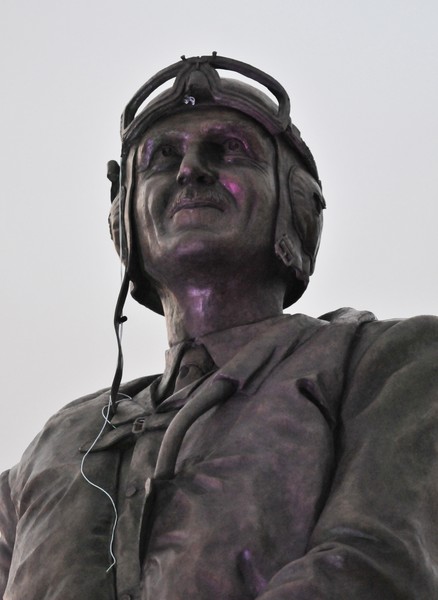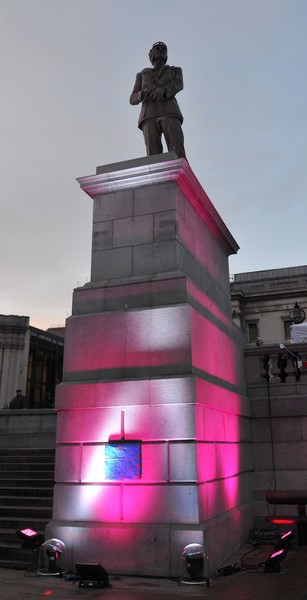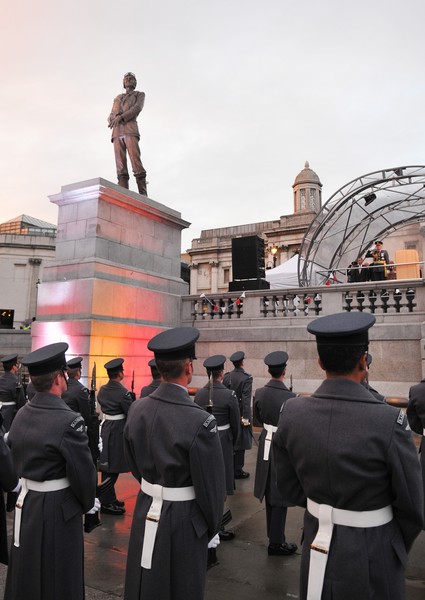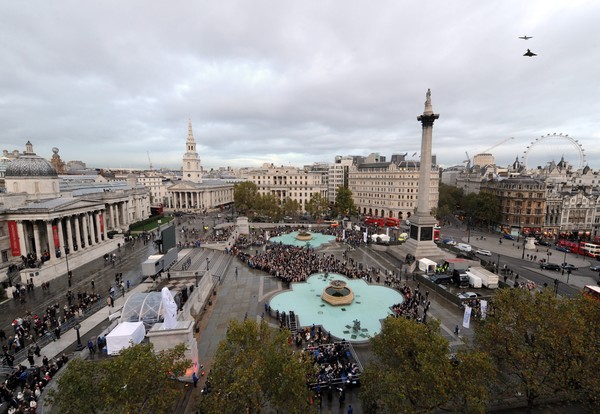Wartime "Saviour of London" is honoured at Trafalgar Square
Thursday 5 November 2009, 8:28AM
By By Steve Willmot
914 views
A statue of Air Chief Marshal Sir Keith Park, who led the Royal Air Force forces over London and the South East of England throughout the Battle of Britain in 1940, was unveiled today on the Fourth Plinth of Trafalgar Square.
The statue, presented by the Sir Keith Park Memorial Campaign (SKPMC) and supported by London Mayor Boris Johnson, will be in place for six months before a permanent memorial statue of Park will be unveiled in nearby Waterloo Place next year on the 70th anniversary of the Battle of Britain.
The unveiling ceremony was attended by Terry Smith, Chairman of the Memorial Campaign, Chief of the Air Staff, Air Chief Marshal Sir Stephen Dalton, WWII RAF veterans and members of Sir Keith Park’s family. Also in attendance were supporters of the campaign to commemorate the wartime leader of the forces that bore the brunt of German attempts to break the RAF and pave the way to an invasion that would have completed Nazi domination of Europe nearly seventy years ago.
An Royal Air Force flypast of a Spitfire from the Battle of Britain Memorial Flight and a Typhoon, both from RAF Coningsby in Lincolnshire, overflew the ceremony. The Typhoon is the modern equivalent to the wartime Spitfire in the role of air defence of the UK.
The ceremonial occasion was supported by the Central Band of the Royal Air Force and its Fanfare Team and the Royal Air Force’s Queen’s Colour Squadron. A large screen in Trafalgar Square broadcasted video footage of Sir Keith Park and RAF Films were played around the ceremony.
Guests included Edward Fox OBE, Dr Stephen Bungay, Flight Lieutenant John Nicol and many representatives and diplomats of the Commonwealth and other countries who fought in the Battle.
Sir Keith Park GCB KBE MC DFC DCL commanded 11 Group of Fighter Command – responsible for the defence of London and the South East. He therefore commanded the squadrons which saw the most intense activity during the Battle of Britain. The Battle went on for many months, but by October 1940, faced with the failure of Nazi Germany to defeat the RAF, Hitler gave up and turned his attention to the Eastern Front.
If Hitler were to invade Britain, or force the British Government to the negotiating table, as a first step he had to gain control of the air. The Battle of Britain was the first major campaign to be fought entirely by air forces. The RAF had 531 serviceable fighters out of a total of 609, in reserve another 289. The Luftwaffe, in total, had 4,539 aircraft. Nearly 3,000 British, Commonwealth and other nations’ pilots from at least 12 countries took part – 544 of them would lose their lives in the Battle of Britain. Many more of those who survived would lose their lives during the remainder of the Second World War, so even by 1945 the “Few” were indeed few.
It is said Air Chief Marshal Lord Hugh Dowding, Commander-in-Chief of Fighter Command controlled the Battle of Britain from day to day, while Keith Park controlled it hour by hour. Park organised and managed his squadrons and men brilliantly, he was respected and admired by many, but also criticised due to the fact that he fought the battle in a defensive manner when some thought greater consideration should have been given to taking the fight to the Germans in an offensive manner. Park's answer was that the role of fighter aircraft was one of defence and should be used in attacking those who were attacking us.
The decision to call off the planned invasion of Britain is seen as Hitler’s first major setback of the Second World War and the statue in London’s Trafalgar Square is regarded as a fitting memorial to Park as it is in the heart of the Capital he helped to defend and beneath Nelson’s Column – a memorial to another commander (this time Naval) who likewise defended Britain from invasion 135 years earlier.
Park was a New Zealander who fought in the First World War in the field artillery at Gallipoli and then the Somme, where he was wounded and evacuated to England. Medically graded unfit to continue service with the artillery, Park joined the Royal Flying Corps, remaining with the air arm when it was incorporated into the Royal Air Force in 1918.
Marshal of the RAF, Lord Tedder, said of Park: "If ever any one man won the Battle of Britain, he did. I don’t believe it is recognised how much this one man, with his leadership, his calm judgement and his skill, did to save not only this country, but the world."
The statue of Sir Keith Park commemorates the approximately 3,000 pilots from 15 countries who fought to defend Britain during the Battle of Britain. Today, there are just over 105 survivors. To the best of the Campaign’s knowledge the nationality breakdown of “The Few” is as follows:-
Australia 33 Belgium 29
Canada 98 Czechoslovakia 88
France 13 Ireland 10
Jamaica 1 Newfoundland 1
New Zealand 126 Poland 145
the Rhodesias 3 South Africa 25
United Kingdom2353 United States 11
Terry Smith, Chairman of the SKPMC, said: “It is an honour to have unveiled a statue of Sir Keith Park in Trafalgar Square today. Park was pivotal in organising the defence of our country and Capital city during the Battle of Britain and was a key figure in ensuring the survival of our nation. A New Zealander, Park was one of many who came from Commonwealth nations and other countries to our aid at one of Britain’s most bleak times in history. As we reflect on the recent anniversary of the beginning of the Second World War, and the story of Sir Keith Park, we should remember the sacrifices made on our behalf by our own forces and by citizens from the Commonwealth and other countries in our ‘Finest Hour’.”
Chief of the Air Staff, Air Chief Marshal Sir Stephen Dalton, commented: “Sir Keith Park was a brave and exceptional fighter pilot; he was an outstanding senior officer, who never failed at any task he was given. He inspired all who worked with and for him, with his quiet gallantry, supreme personal inspiration, organisation and mental agility. He is a hero to the Royal Air Force, to this country, and to New Zealand, whose citizens have so often joined us in battle, from the World Wars through the Falklands to the present day.”
London Mayor Boris Johnson said it was an important moment: "London owes an enormous debt to Sir Keith Park for his courage and leadership, which helped to win the Battle of Britain. Hosting a temporary memorial in Trafalgar Square in time for the 70th anniversary of this epic battle is a mark of our gratitude for the bravery and commitment this great hero showed to London and the world. And it was lovely to listen to a Spitfire Engine over London, still capable of setting off car alarm. His determination not to give in during the Battle of Britain has led directly to London being the democratic, tolerant Capital it is today"
Edward Fox OBE said: “Quality of leadership exists in varying capacities. In differing degrees it is possessed by many. The power of great leadership however belongs to only a few and was quintessentially decisive in determining the outcome against the enemy that Great Britain, which as a country was not well prepared, had to face in 1940.
“However gallant and courageous the nation’s forces unquestionably were, it was great leadership which galvanised that spirit and propelled it to victory against a formidable and better-armed enemy. Such men are rare. Such a man was Sir Keith Park.”
Planning permission was granted by Westminster City Council in May this year for a temporary statue of Park to be installed on the Fourth Plinth in Trafalgar Square.
Commenting on the unveiling, Air Vice-Marshal Greg Bagwell, the modern day equivalent of Sir Keith Park, who currently commands the Air Defence fighter squadrons that protect UK airspace today, commented:
“One of the Royal Air Force’s key roles, on its formation in 1918, was and remains the control of the airspace above the UK, to ensure that the country is safe from air attack. Today, as they were during the Battle of Britain, a force of fighter aircraft are held on ‘quick reaction alert’ all year round, day and night, with a remit to ‘scramble’ within a few minutes to intercept any aircraft that enters the UK’s airspace without proper authorisation. Sir Keith Park’s legacy endures today through the unwavering courage, professionalism and dedication of the men and women who serve in the Royal Air Force.”
Hazel Gregory (88) from Sleaford was an 18-year-old Senior Aircraftwoman fighter-plotter in the 11 Group bunker at RAF Uxbridge during the Battle of Britain. She said: “I remember Sir Keith well – he was always there making decision after decision. He was a lovely man – and he used to bring us girls bags of licorice allsorts.
“We never had time to think about what would happen if the German bombers got through. It was a very busy time – I was once at the Watford end of the table and I remember one 400 aircraft raid – you couldn’t see the surface of the table it was so covered with movements. That day I remember Sir Keith talking about bringing down the “Big Wing” from 12 Group to help out and they smashed through the enemy aircraft.”
Hazel was later offered an officer commission and worked at Bletchley Park in the famous code-breaking “Hut 6” and finished the war as a Flight Lt.
One of the “Few” was Bill Green was an aircraftman 2nd Class fitter in the RAF in 1938 when he applied to become aircrew. He said: “Once the War started everything became a blur - I was only half trained on 501 County of Bristol Sqn when I was posted to Biggin Hill’s 32 Sqn flying Hurricanes. My CO pointed to an aircraft and said “that’s yours”. I had never flown one before and I had only done one circuit when I was told to land because an air battle was beginning. I overshot the runway and stopped just 6 yards from the hedge.”
Later in the Battle Bill, by now a Sgt pilot, was shot down by flak at 20,000ft after engaging a Junkers JU88 over Deal in Kent. He was blown out of his Hurricane, losing his boots on the way. “My parachute wrapped around me and only opened at 200ft. One more second and I would have been dead.”
Added Terry Smith: “It has taken 69 years to give expression to what Sir Keith Park acheieved. There is no conclusion other than if this Battle of Britain in 1940 had been lost, then the outcome of the Second World War, and our current lives, would have been very different. Trafalgar Square currently celebrates the Nation’s military heroes – naval, army and now Royal Air Force. It can truly be termed a ‘Square for Heroes.’
In August 1940 Prime Minister Winston Churchill said: “The gratitude of every home in our island, in our Empire, and indeed throughout the world except in the abodes of the guilty goes out to the British airmen who, undaunted by odds, unweakened by their constant challenge and mortal danger, are turning the tide of world war by their prowess and their devotion.
Never in the field of human conflict was so much owed by so many to so few.”
http://www.youtube.com/watch?v=8dqcfgYNmm0
http://www.youtube.com/watch?v=wRjR99lR_7c
http://www.youtube.com/watch?v=SMs5DRa_LuQ
http://www.youtube.com/watch?v=Kf5EGnXg284



